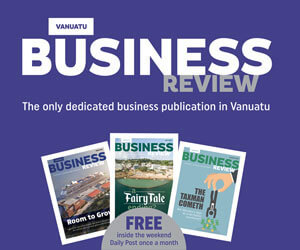Telstra’s Pacific adventure: a radical pivot or a deal too good to refuse?
July 31, 2021 10:00 am | Posted in Features | Share now TwitterFacebook

Telstra’s bid for an osbsure telecoms operator in the South Pacific was probably far from Prime Minister Scott Morrison’s mind as he fronted up for a press conference at the Lodge this week to discuss the COVID-19 pandemic.
But after this masthead revealed the nation’s biggest telco and government were working in concert to acquire Digicel Pacific due to concerns it might otherwise fall into the hands of China, journalists wasted little time in asking him about it.
The reality is that parts of the government have been fixated for months on the sale of the telco, which is owned by Irish billionaire Denis O’Brien. In a sign of how seriously the situation is being taken, Communications Minister Paul Fletcher tapped telecommunications veteran Bob Mansfield late last year to keep in touch with Digicel about potential transactions after its talks with a private equity firm fell through.
The $44.7 billion ASX-listed telco giant confirmed the deal discussions on Monday morning following a story in The Sydney Morning Herald and The Age last weekend, surprising not just press gallery journalists but also the telecommunications industry and investment community.
It isn’t difficult to understand why, because at face value, this would be a radical pivot for Telstra. Chief executive Andy Penn has spent the past few years de-cluttering and simplifying the telco’s operations and divesting its non-core assets. The last time he attempted to expand Telstra’s reach offshore – through an aborted purchase of a Philippines mobile operator – he was severely admonished by shareholders.
At the press conference, Morrison was asked whether the government could guarantee taxpayers would not lose any money on the proposal. “That’s a matter between him and his shareholders,” the Prime Minister told reporters, referring to Penn. “They have commercial objectives which they pursue, and I wouldn’t expect them to be doing anything that wasn’t in their commercial interests”.
But Telstra’s army of 1.2 million retail shareholders will be less concerned about taxpayer money being risked on the deal and more concerned about their own. Telstra has burned billions in its adventures offshore in the past.
The company’s chairman John Mullen later stated the company would not make an investment that didn’t make financial sense or deliver a return. investors could be forgiven for having some doubts.

‘It would create vulnerabilities’
Denis O’Brien, an Irish billionaire and media mogul, started fielding inbound inquiries for his Digicel Pacific and Digicel Caribbean mid-last year, shortly after a restructure of its debt. Digicel was initially approached by Kumul Telikom executive Andrew Johnson, who was working with a consortium to secure private equity interest to buy the
company’s South Pacific operations.
By June, it was clear the Australian federal government was interested and several months later it appointed
Macquarie bankers John Pickhaver and Michael Milne to assist on a potential deal. Two private equity firms – Pacific
Equity Partners and Blackstone – looked at the assets, while the former made several offers, according to multiple
people close to the negotiations.
But there is also alleged interest from Chinese-owned telco operators including China Mobile and ZTE. As efforts by PEP were rejected by O’Brien and his team late last year, the company appointed former federal treasurer Joe Hockey’s
firm, Bondi Partners as advisers.
As the talks stalled, the federal government asked Bob Mansfield – a former Telstra chairman – to stay in touch
with Digicel and keep it in the loop if a deal by an international entity was near. But it wasn’t until January this year that
Digicel was finally approached by Telstra about the prospect of doing a deal to acquire the dominant mobile operator in Fiji, Papua New Guinea, Nauru, Samoa, Tonga and Vanuatu.
Sources familiar with the offer made by Telstra and the federal government said it is worth about $2 billion. Under
the proposal, Telstra would spend between $200 million and $300 million of its own money while the government
would provide a loan for the remaining $1.5 billion. That loan would need to be repaid over a period with an interest rate of 3 per cent. It would be provided by the government’s export credit agency, which can provide loans and guarantees to Australian business for overseas projects.
The offer is subject to due diligence but, if successful, would give Telstra control over the largest mobile operator in the
South Pacific, which also runs a pay TV service, a free-to-air TV channel and internet services.
Digicel also owns a Caribbean business and is in advanced talks to sell it to Moscow Telecom.
From the perspective of the government, the geostrategic stakes are high. Australia (and the US), do not want
China extending its influence in the South Pacific.
Michael Shoebridge, director of the defence and national security program at the Australian Strategic Policy Institute,
said there were too many risks in letting a Chinese state-owned company gain a foothold in the South Pacific by
controlling key telecommunications assets.
He said the consequences would be far worse than the recent wave of hacks on Microsoft Exchange systems,
which a coalition of countries this week attributed to China. This is because China would be able to access the data
through the front door, he said.“It would create vulnerabilities far larger than the clear vulnerabilities from cyber hacking.”
China has expanded its influence in the region in recent years by providing loans and foreign aid to small Pacific countries and buying strategically important assets such as ports. The federal government already spent almost $100
million on an undersea cable from Australia to Papua New Guinea and the Solomon Islands to stop Chinese telco
Huawei gaining a foothold in the Pacific. A potential acquisition of Digicel Pacific by a Chinese entity would add to its
concerns.
This also puts O’Brien in a difficult position: while the price may be right with a Russian or Chinese company, it
risks upsetting geopolitical rivals such as the US and Australia.
Yet if the deal goes ahead, there may also be challenges for Telstra. Digicel networks run on equipment supplied by Huawei which has been unceremoniously drummed out of the Australian 5G market and from supplying the national broadband network by the federal government.
The Ericsson relationship has been a fruitful one for Telstra but bringing Digicel into its fold will see the telco
having to maintain a network running on Huawei’s equipment. As such, bringing Digicel into the fold could at the very
least provide another distraction that Telstra could do without.
‘Complicated situation’ for shareholders
Even with its national security benefits, the deal has raised eyebrows among Telstra watchers both in the telco
industry and in the financial markets.
Research from Ord Minnett last Monday said the transaction would contribute an uplift of 5 per cent to net profit after
tax in 2022, and 4 per cent in 2023. But that was based on the assumption that any money paid by the government
would not need to be refunded. Penn has in recent years focused on simplifying Telstra’s sprawling operations
as the company confronts the loss of its wholesale fixed-line monopoly to the National Broadband Network and much
tighter margins in the highly competitive mobile market.
Buying a new asset, especially one such as Digicel Pacific, runs counter to the leaner, fitter ethos Telstra has been keen to project. The telco’s recent international adventures all hark back to a time when it was desperately seeking
avenues to grow. Investors Mutual senior portfolio manager, Daniel Moore, said the Digicel deal was a “complicated situation”. “As shareholders, we take a lot of comfort that John Mullen is the chairman and he is proven to be very
disciplined and focused on returns. He’s made good strategic decisions during his tenure,” he said. “Given the company has a very strong balance sheet post the mobile tower sale, they have a number of capital management options, we trust John and the board will make the right decision for shareholders.” Telstra still has a strong international presence and is in the process of separating this division from its core business as part of a legal restructure.
That division contains a large subsea cable network that has licences in Asia, Europe and the US. The value
in this division comes from managing data traffic for the company’s major clients including Google, Facebook and
Microsoft. It’s an area of increased focus for Telstra, which earlier this year considered a merger with Hong-Kong based operator PCCW Global. Sources close to the deal, who were not authorised to speak publicly, indicated Telstra’s interest
in Digicel was about diversifying its international business and increasing its geographical footprint.
A successful deal would add a 3G and 4G mobile phone network, undersea cables in the region, 975 towers cell in Papua New Guinea, TV and broadband services to Telstra’s international division. It has 2.5 million customers and nearly 2000 employees.
flummoxed by this week’s confirmation of deal talks wonder if there is something missing from the picture that would
better explain it: a quid pro quo with the government that may have occurred to seal the partnership and that brought
Telstra to the negotiating table. Most observers are convinced Telstra has struck some sort of deal involving
NBN Co. But they say it’s unlikely the government would give Telstra anything that affects future competition in the
Australian sector. Telstra attempted to monetise up to $5.5 billion worth of future income from national broadband
network payments in 2017, but it was quickly shut down. Could this deal be revisited?
Others have assured that Telstra would see this as a patriotic duty, a view that has persisted inside the former
government monopoly even after it was privatised.
A good time to sell
While sources close to Digicel say a deal isn’t urgent or imminent, it is a good time for O’Brien to sell. While his telco has raw growth potential, it has high debt levels and its earnings have been weaker because of the coronavirus pandemic. It is also a hard company to manage in a pandemic from Dublin, where O’Brien (a typically hands on executive) is based.
Some senior government figures have also warned O’Brien, a wily businessman, could be using tensions between Australia and China as an opportunistic play to maximise his exit price.
Whatever the case, the move by the government to assist in a corporate deal for geostrategic reasons seems without
precedent in Australia, at least in recent memory. Shareholders can only hope they will not be left holding the bag.
“Would it have been something one would have gone further in discussion with if it wasn’t a government interest?
Probably not,” Telstra chairman Mullen said this week. “That said, can you help your sovereign government in
times, particularly if you’re a critical infrastructure provider? Well of course
you can.”










